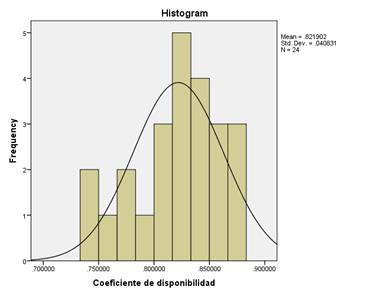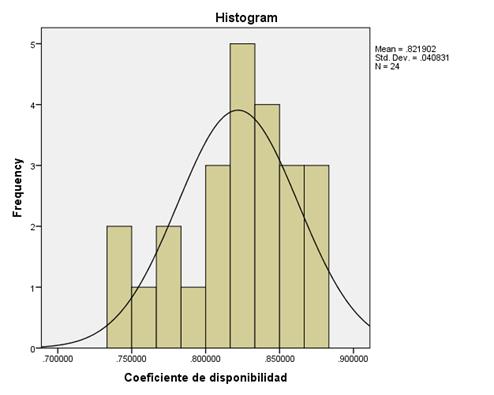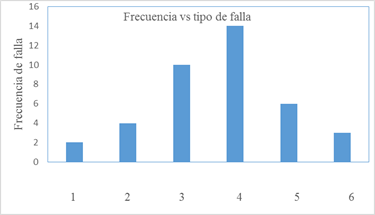Translate PaperORIGINAL ARTICLE http://opn.to/a/xgyVD
http://opn.to/a/xgyVDBehavior of Operating Indicators of Massey Fergunson 5650 Grain Harvester
[
*
] Correspondence to author: Claudio Bautista Pérez Olmo. e-mail: claudio@unica.cu
ABSTRACTDue to the high cost of Massey Fergunson 5650 grain harvesters, proper use of these machines is necessary. In Ciego de Ávila Province, with many areas dedicated to the cultivation of grains, these machines have a wide use. The work consisted of evaluating the balance of shift time of the harvesters, technical availability coefficient, the most frequent failures and productivity and agricultural yield of the fields. The coefficient of technical availability 0.82, still has the potential to improve the use of machines and it is possible to take technical and organizational measures. The most frequent faults were in the cutting system and in the harvest system. The productivity of the harvesters with an average of 1.6 t / h was low considering the potential of these machines. The main causes of this poor performance are given by low effective use of shift time (average 69%), low agricultural yields (average of 1.15 t / ha) and inadequate state of the fields for harvesting.
INTRODUCTIONIn recent decades there have been worldwide increases in the mechanization of grain crops to increase productivity, due to the growth of the sown areas and the short amplitude of the time of harvest. Brazil is the world's largest producer of grains with more than three million tons per year according to Campos et al. (2016), with agricultural yields ranging from one to two t/ha (Moreira et al., 2013). In Cuba, production does not satisfy demand and this forces imports. The introduction of modern machines has increased the harvesting capacity of Cuban agriculture. In the province of Ciego de Ávila the Massey Fergunson 5650 harvesters do not reach the expected productivity
When referring to the productivity of grain harvesters, Pérez et al. (2014) explain that in the last instance it is determined by the maximum feeding in the threshing system, that is to say, by the capacity of feeding of the combined. That depends on the type and dimensions of the threshing structures and work regime, its regulations, crop conditions, engine power, surface conditions of the field in harvest, among others.Miranda et al. (2013) points out that the use of the shift time of the harvesters shows a great reserve of the increase in productivity. Agricultural yields influence both the speed of the machine and its productivity, in Cuba bean agricultural yields are reported variable between one and three t/ha (Chacón, 2012; Maqueira et al., 2016; González-Rojas et al., 2017).
Iglesias et al. (2012) refer that in Cuba, there are several factors affecting the harvest of grains. They are excessive weeding, action of microorganisms, deficiency in the planning of the harvest and different regulations of the threshing structures. Miranda et al. (2016), highlights the importance of an adequate productivity of the harvester for a low energy cost per processed mass. One of the factors that most affects productivity is the reliability of the machine. Several authors have characterized the exploitation reliability coefficient using different variants (González-Rojas et al., 2017). For New Holland TC-57 they report values from 0.58 to 0.62 considering the time invested in the management and search of the pieces and from 0.82 to 0,83 without considering that time.Miranda et al. (2015), obtained for CLAAS Dominator harvester, values of 0.92 for the chronometric variant and 0.87 for the cost variant. This suggests the need to improve the technological discipline in carrying out technical maintenance operations and have the necessary parts, instruments and devices for these operations. The evaluation of the productivity of the grain harvesters in the conditions of Ciego de Ávila province will allow the producers to know the performance of their machines, as well as the factors that can be improved to increase their productive efficiency. Hence, the objective of this work was to evaluate the factors that affect the productivity of these harvesters, evaluating the use of shift time, technical availability and the main faults.
METHODSThe balance of shift time is an important tool to evaluate the harvest-transport process of grains, the rational use of clean working time and those that affect productivity (Iglesias et al., 2012). Measurements of the area worked and the mass of grains in the unit of time allows us to determine the productivity of the harvesters as well as the agricultural yield.
where:- Hourly productivity, t / h.
- Coefficient of use of the work front.
- Agricultural yield, t / ha.
- Coefficient of use of shift time.
Maintenance is a key factor in increasing productivity, reducing the number of stops, decreasing costs and making machines work correctly, according to specifications (Herrera et al., 2012). Hence, determining the main failures and their causes is a decisive step to achieve that goal. The identification of faults and faults can be conducted with different philosophies or work strategies according to Shkiliova y Fernández (2011): proactive maintenance, predictive maintenance, corrective maintenance and maintenance engineering.
This suggests a systematic follow-up of the reliability indicators to keep the equipment in the predictive field. Another feature highlighted by Herrera et al. (2012), as a very important one to maintain high availability is the maintainability of the machine (with the training and resources necessary for maintenance). Regarding the technological process of the harvesters, Cassia et al. (2015), comment that the techniques of real-time monitoring of the harvest allow interacting with the different systems of the machine that determine their productivity and quality of harvest.
Several authors have studied the availability of harvesters as a cause of low yields. The Kd technical availability coefficient correctly describes the level of performance of the machine depending on its reliability (De la Cruz et al., 2013; Uttaro et al., 2015):
where:- Sum of machine time in good technical condition.
RESULTS AND DISCUSSIONChronometer measuring through photos of the process was developed in 24 days. For the statistical analysis, the Excel and SPSS version 21 tools were used. The value of the shift time coefficient was under 0.69. The productivities of the harvester (Table 1) may also be higher, so work must be done on aspects such as reduction of auxiliary times, better preparation of the field for harvesting, updated history of element changes and maintenance performed on the machine, training of operators, improving of technological processes and maintenance operations of grain harvesters.
The statistical treatment of the productivities appears in Table 1.
TABLE 1
Statistical analysis of productivities
| Variable | Mean | Error | Standard Deviation | Skewness | Kurtosis |
|---|
| Agricultural Performance t/ha | 1,1500 | 0,00949 | 0,03795 | 0,402 | -1,598 |
| Hourly productivity ha/h | 1,8663 | 0,05976 | 0,23902 | -1,585 | 6,854 |
| Hourly productivity t/h | 1,6231 | 0,05374 | 0,21496 | -0,836 | 5,577 |
| Daily Productivity t/jor | 11,7419 | 0,57219 | 2,28878 | -2,113 | 3,987 |
In the statistical treatment, acceptable values were obtained for the means of productivities and less concentrated values of agricultural yields.
The coefficient of technical availability (Figure 1) of average 0.82, still has a good reserve to improve the performance of the harvesters, their hourly performance and reduce operating costs.
To analyze the faults (in which 39 were presented), it is important to consider aspects such as: system where the failure occurs, impact and causes of it. The frequency of occurrence of the fault indicates the level of prevention and ability to restore the failure that each element requires. Most frequent failures: three and four, faults in the cutting system and failures in the harvesting system. The observed faults were: (Figure 2).
Failure in the capacity of the brake system.
Failures in the hydraulic system.
Failures in the cutting system.
Failures in the harvest system.
Failures in the air conditioning system.
The electrical system fails.
Behavior of the availability coefficient
CONCLUSIONSThe productivity of the harvesters can be increased by reducing the losses of time during the day, improving the conditions of the field for the harvest and achieving higher agricultural yields.
The coefficient of technical availability still has reserves for its increase, which can be achieved by improving the organization, quality and control of maintenance operations so that it is preventive if the most frequent failures of the harvesters are known.
Traducir DocumentoARTÍCULO ORIGINAL http://opn.to/a/xgyVD
http://opn.to/a/xgyVDComportamiento de los indicadores de explotación de la cosechadora de granos Massey Fergunson 5650
[I] Universidad de Ciego de Ávila Máximo Gómez Baez, Facultad de Ciencias Técnicas, Ciego de Ávila, Cuba.
[
*
] Autor para correspondencia: Claudio Bautista Pérez Olmo. e-mail: claudio@unica.cu
RESUMENDebido al alto costo de las cosechadoras de granos Massey Fergunson 5650, es necesario un apropiado uso de estas máquinas. En la provincia de Ciego de Ávila, con muchas superficies dedicadas al cultivo de granos, estas máquinas tienen un amplio uso. El trabajo consistió en evaluar: el balance de tiempo de turno de las cosechadoras, coeficiente de disponibilidad técnica, las fallas más frecuentes, productividad y rendimiento agrícola de los campos. El coeficiente de disponibilidad técnica 0,82 posee aún potencial para mejorar el uso de las máquinas se puede toman medidas técnicas y organizativas. Las fallas más frecuentes estuvieron localizadas en el sistema de corte y el sistema de cosecha. La productividad de las cosechadoras con una media de 1,6 t/h resultó bajo si se consideran las potencialidades de estas máquinas. Las causas principales de este pobre desempeño están dadas por: baja utilización efectiva del tiempo de turno (media 69%), bajos rendimientos agrícolas (media de 1,15 t/ha) e inadecuado estado de los campos para la cosecha.
INTRODUCCIÓNEn las últimas décadas se han producido mundialmente incrementos en la mecanización de los cultivos de granos para elevar la productividad, debido al crecimiento de las áreas sembradas y la poca amplitud del momento de cosecha. Brasil es el mayor productor mundial de granos con más de tres millones de toneladas al año según Campos et al. (2016), con rendimientos agrícolas que oscilan entre una y dos t/ha (Moreira et al., 2013). En Cuba la producción no satisface la demanda y esto obliga a la importación. La introducción de modernas máquinas ha aumentado la capacidad de cosecha de la agricultura cubana. En la provincia de Ciego de Ávila las cosechadoras Massey Fergunson 5650 no alcanzan la productividad prevista
Al referirse a la productividad de las cosechadoras de granos Pérez et al. (2014), explica que en última instancia es determinada por la alimentación máxima en el sistema de trilla, es decir por la capacidad de alimentación de la combinada, la cual depende del tipo y dimensiones de los órganos de trilla y régimen de trabajo, sus regulaciones, condiciones del cultivo, potencia del motor, condiciones de la superficie del campo en cosecha, entre otros. Miranda et al. (2013), señala por su parte que la utilización del tiempo de turno de las cosechadoras presenta una gran reserva de la elevación de la productividad. Los rendimientos agrícolas influyen tanto en la velocidad de la máquina como en su productividad, en Cuba se reportan rendimientos agrícolas de frijol variables entre una y tres t/ha (Chacón, 2012; Maqueira et al., 2016; González et al., 2017).
Iglesias et al. (2012) refieren que en Cuba hay varios factores que afectan la cosecha de granos: exceso de enyerbamiento, acción de los microorganismos, deficiencia en la planificación de la cosecha y diferentes regulaciones de los órganos de trilla. Miranda et al. (2016), destaca por su parte la importancia de una adecuada productividad de la cosechadora para un bajo costo energético por masa procesada.
Uno de los factores que más afecta la productividad es la fiabilidad de la Máquina. Varios autores han caracterizado el coeficiente de fiabilidad de explotación usando diferentes variantes. (González et al., 2017), para la New Holland TC-57 obtiene valores de (0,58…0,62) considerando el tiempo invertido en la gestión y búsqueda de las piezas y (0,82-0,83) sin considerar ese tiempo. Miranda et al. (2015), obtuvo para la cosechadora CLAAS Dominator valores de 0,92 para la variante cronométrica y 0,87 para la variante de costo. Esto sugiere la necesidad de: mejorar la disciplina tecnológica en la realización de las operaciones de mantenimiento técnico y disponer de las piezas, instrumentos y dispositivos necesarios para estas operaciones.
La evaluación de la productividad de las cosechadoras de granos en las condiciones de la provincia Ciego de Ávila le permitirá a los productores conocer el desempeño de sus máquinas, así como los factores de pueden ser mejorados para aumentar su eficiencia productiva. Es por ello que el objetivo del presente trabajo fue evaluar los factores que afectan la productividad de estas cosechadoras, evaluando el uso del tiempo de turno, la disponibilidad técnica y las principales fallas.
MÉTODOSEl balance del tiempo de turno es una importante herramienta para evaluar el proceso de cosecha- transporte de los granos y el uso racional del tiempo limpio de trabajo y las que afectan la productividad (Iglesias et al., 2012). Mediciones del área trabajada y de la masa de granos en la unidad de tiempo nos permite determinar la productividad de las cosechadoras así como el rendimiento agrícola.
donde: - Productividad horaria, t/h.
- Coeficiente de utilización del frente de labor.
- Velocidad de trabajo, km/h.
- Rendimiento agrícola, t/ha.
- Coeficiente de utilización del tiempo de turno.
El mantenimiento es un factor clave en el incremento de la productividad, al reducir el número de paradas, en la disminución de los costos y conseguir que las máquinas funcionen correctamente, según especificaciones (Herrera et al., 2012). De ahí que determinar las principales fallas y sus causas sea un paso decisivo para lograr ese objetivo. La identificación de fallas y averías se puede conducir con diferentes filosofías o estrategias de trabajo según Shkiliova y Fernández (2011): de mantenimiento proactivo, de mantenimiento predictivo, de mantenimiento correctivo, de ingeniería del mantenimiento.
Esto sugiere un seguimiento sistemático de los indicadores de fiabilidad para mantener los equipos en el campo predictivo. Otra característica destacada por Herrera et al. (2012), como muy importante para mantener una alta disponibilidad es la mantenibilidad de la máquina (con la capacitación y recursos necesarios para el mantenimiento). En cuanto al proceso tecnológico de las cosechadoras, Cassia et al. (2015), comentan que las técnicas de monitoreo en tiempo real de la cosecha permite interactuar con los diferentes sistemas de la máquina que determinan su productividad y calidad de cosecha.
Varios autores han estudiado la disponibilidad de las cosechadoras como causa de bajos rendimientos. El coeficiente de disponibilidad técnica Kd describe con acierto el nivel de prestaciones de la máquina en dependencia de su fiabilidad (De la Cruz et al., 2013; Uttaro et al., 2015):
donde:- Sumatoria de tiempo de máquina en buen estado técnico.
- Tiempo empleado para las reparaciones.
RESULTADOS Y DISCUSIÓNEl fotocronometraje se desarrolló en 24 jornadas. Para el análisis estadístico se utilizaron las herramientas Excel y SPSS versión 21. El valor del coeficiente de tiempo de turno estuvo bajo 0,69. Las productividades de la cosechadora (Tabla 1) también pueden ser mayores, por lo que debe trabajarse en aspectos como: Reducción de los tiempos auxiliares, mejor preparación del campo para la cosecha, historial actualizado de los cambios de elementos y mantenimientos realizados a la máquina, capacitación de operadores, mejorar los procesos tecnológicos y operaciones de mantenimiento de las cosechadoras de granos.
El tratamiento estadístico se las productividades aparecen en la Tabla 1.
TABLA 1
Análisis estadístico de las productividades
| Variable | Media | Error | Desviación Standard | Skewness | Kurtosis |
|---|
| Rendimiento Agrícola t/ha | 1,1500 | 0,00949 | 0,03795 | 0,402 | -1,598 |
| Productividad horaria ha/h | 1,8663 | 0,05976 | 0,23902 | -1,585 | 6,854 |
| Productividad horaria t/h | 1,6231 | 0,05374 | 0,21496 | -0,836 | 5,577 |
| Productividad jornada t/jor | 11,7419 | 0,57219 | 2,28878 | -2,113 | 3,987 |
En el tratamiento estadístico se obtuvieron valores aceptables para las medias de las productividades y valores menos concentrados de los rendimientos agrícolas.
El coeficiente de disponibilidad técnica (Figura 1) de media 0,82 tiene aún una buena reserva para mejorar el desempeño de las cosechadoras, su rendimiento horario y disminuir los costos de operación por
Para analizar las fallas (en las que se presentaron 39) es importante considerar aspectos como: sistema donde ocurre la falla, impacto de esta falla y causas de la falla. La frecuencia de ocurrencia de la falla indica el nivel de prevención y capacidad de restablecimiento de la falla que cada elemento exige. Fallas más frecuentes: las tres y cuatro: fallas en el sistema de corte y fallas en el sistema de cosecha. Las fallas observadas fueron: (Figura 2).
Falla en la capacidad del sistema de freno.
Fallas en el sistema hidráulico.
Fallas en el sistema de corte.
Fallas en el sistema de cosecha.
Fallas en el sistema de aire acondicionado.
Falla el sistema eléctrico.
Comportamiento del coeficiente de disponibilidad
Comportamiento de las fallas.
CONCLUSIONESLa productividad de las cosechadoras puede aumentarse disminuyendo las pérdidas de tiempo durante la jornada, mejorando las condiciones del campo para la cosecha y logrando mayores rendimientos agrícolas.
El coeficiente de disponibilidad técnica aún tiene reservas para su incremento, lo cual puede lograrse mejorando la organización, la calidad y el control de las operaciones de mantenimiento para que sea preventivo si se conocen las fallas más frecuentes de las cosechadoras.










